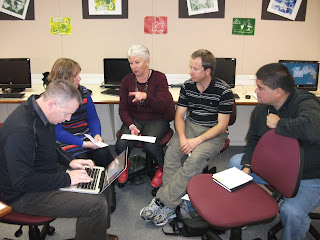Kawaha Point Middle Team Reflects
Do you have a 'go to' SOLO resource? (and if so what is it?)
At Kawaha Point school our curriculum guideline folder contains a set of SOLO resources for our reference. It contains examples of blank HOT maps with the accompanying rubrics and the new visual rubrics which are very helpful to explain the learning outcomes to children. The new visual rubrics are child-friendly because they can see the expectation for each level.
What barriers are (or were there) for you infusing SOLO in your classroom and why (or how have you overcome them)?
The initial barrier was our lack of knowledge of how SOLO works, HOT map use and writing effective rubrics. We have overcome this by having a go, failing and trying again (like we expect children to do)! We also benefitted from sharing within our school/cluster our successes and failures.
Our next challenge was getting the children to understand the rubrics and that their achievement changes from task to task. Eg. "But I am extended abstract" - the children need to understand that their learning outcome was extended abstract for that particular piece of work and they may achieve a different level for other tasks.
We were also challenged to get our children to identify their next steps to achieve a better learning outcome. Eg. "My piece of work is 'multistructural' because... and I need to ... to achieve relational".
We have had to be sensible with how and when we have used SOLO maps so it is not overdone and the children still enjoy using the maps.
Time is another factor that effects all teachers. This can be overcome by working together (we don't all individually need to write our own rubrics), integrating SOLO into our long term plan and encouraging others to use it!
_______________________________________________________
Ngongotaha Middle Team Reflects
What do you see as a ‘negative’ of SOLO? (How could you overcome this?)
- No Rumaki networking/sharing group
- Break down the terms of SOLO and then teaching the language of SOLO to second language learners
- Linking of SOLO to Whanaketanga and curriculum
- Different terms used within different schools Rumaki units.
- Online resources offered in mainstream are not offered in Te Reo. (ICT)
How can you overcome this:
- Source other schools that are using SOLO and have a Rumaki unit
- Networking wherever there is a chance
- Making time to translate SOLO vocab in to Te Reo
- Have funding for someone to organise and connect Rumaki teachers around New Zealand- even online.
Mamaku Middle Team Reflects
Otonga and Kaharoa Middle Teachers Reflect
Check this out on Chirbit
______________________________________________________
St Mary's and Aorangi Middle Team Reflects
What has happened for SOLO to become a ‘common language’ across your team?
Plan collaboratively – we have thinking time because we know what our concept is is as we are on a 2 year cycle.
We share examples of learning and teaching through our regular team .
meetings.
Everyone’s class has solo language displayed.
One staff member has premade reflection starter strips for children to use then they are recording their solo stage and next steps.
Staff are adapting the maps to suit the needs of
“Learning to learn’ requires the learner to think about the strengths and weaknesses of their own thinking when they are learning and to make thoughtful decisions on what to do next.
Doing the work is not enough these days, reflecting on next steps and feedback is critical is critical. Teachers deliberately teach students to reflect.
Using Knowledgenet as a tool for reflecting and showcase.
What has changed in you classroom due to the use of solo.
Teachers are dipping in and out of success criteria and solo rubrics – depending on the task and the needs of the students.
Students are more reflective , as well as using the e-portfolios. The children are more aware of their next learning steps, this has clarified the next steps , especially after going through the ATOL programme where we thought it was difficult to show the students where to go next at times.
“Education is not like the filling of a bucket, but the lighting of a fire” – W. B Yeats.
The ignition day at St Mary's was great for setting the fire.
Having concepts that the students are interested in and are real – Volcanoes – linked to us living in a caldera. Making sure we access experts and have school trips is important for the students to broaden their learning. E.g. going to the Museum and Buried village. We have writing links to the concept – this term our writing focus in explanation to link to the concept.
________________________________________________________





